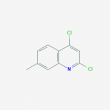
2,4-DICHLORO-7-METHYLQUINOLINE - 100mg
Short description
2,4-DICHLORO-7-METHYLQUINOLINE
Discover the exceptional versatility of 2,4-DICHLORO-7-METHYLQUINOLINE, a high-purity (95%) chemical compound with a captivating molecular structure. Boasting a CAS number of 102878-19-3 and a molecular weight of 212.0753g/mol, this solid material offers a unique blend of properties that make it a valuable asset in various research and development applications. Handle with care, as it may cause skin irritation, eye irritation, and respiratory discomfort. Ensure proper storage in a cool, well-ventilated area to maintain its exceptional quality. Unlock the potential of this remarkable compound and elevate your scientific endeavors to new heights.
- CAS: 102878-19-3
- Ref #: AN-AG01DLKA
- Molecular Formula: C10H7Cl2N
- Purity: 95%
- Color/Form: Solid
- Melting Point: 106 - 108°C
- Molecular Weight: 212.0753
-
Procurenet Team Tshim Sha Tsui
Hong Kong 3 years
Description
2,4-DICHLORO-7-METHYLQUINOLINE
Unlock the versatile potential of 2,4-DICHLORO-7-METHYLQUINOLINE, a highly specialized chemical compound that holds the key to unlocking new frontiers in scientific research and development. With its unique molecular structure and exceptional purity, this compound is a valuable asset for researchers and chemists across various industries, from pharmaceuticals to material science.
At the heart of this compound lies a quinoline core, adorned with strategic chloro and methyl substituents. This intricate arrangement of atoms bestows 2,4-DICHLORO-7-METHYLQUINOLINE with a distinct chemical profile, making it a sought-after building block in the pursuit of innovative solutions. With a CAS number of 102878-19-3 and a reference number of AN-AG01DLKA, this compound is meticulously crafted to meet the highest standards of quality and purity, ensuring reliable and consistent results in your research endeavors.
Unraveling the Potential
The versatility of 2,4-DICHLORO-7-METHYLQUINOLINE lies in its diverse applications across various scientific domains. Its unique molecular structure and properties make it a valuable asset in the following areas:
Pharmaceutical Research
In the realm of pharmaceutical research, 2,4-DICHLORO-7-METHYLQUINOLINE serves as a crucial starting material or intermediate in the synthesis of novel drug candidates. Its quinoline core and strategic substitutions allow for the development of compounds with improved pharmacological profiles, targeting a wide range of therapeutic areas, from neurological disorders to infectious diseases.
Agrochemical Innovation
The agricultural industry also benefits from the versatility of 2,4-DICHLORO-7-METHYLQUINOLINE. This compound is employed as a building block in the synthesis of advanced crop protection agents, such as pesticides and herbicides. Its distinct molecular structure contributes to the development of more potent and selective agrochemicals, helping to safeguard crops and enhance yields while minimizing environmental impact.
Material Science Advancements
Beyond the realms of pharmaceuticals and agrochemicals, 2,4-DICHLORO-7-METHYLQUINOLINE finds applications in the field of material science. Researchers utilize this compound to engineer novel materials with tailored properties, such as improved thermal stability, mechanical strength, or optical characteristics. These advancements can lead to the creation of innovative products with enhanced performance and functionality.
Technical Specifications
- CAS Number: 102878-19-3
- Reference Number: AN-AG01DLKA
- Molecular Formula: C10H7Cl2N
- Molecular Weight: 212.0753 g/mol
- Purity: 95%
- Physical Form: Solid
- Melting Point: 106 - 108°C
Safety and Handling
2,4-DICHLORO-7-METHYLQUINOLINE is classified as a hazardous substance, with the following hazard statements:
- H302: Harmful if swallowed.
- H315: Causes skin irritation.
- H319: Causes serious eye irritation.
- H335: May cause respiratory irritation.
When handling this compound, it is essential to wear appropriate personal protective equipment, such as protective gloves, clothing, eye protection, and a face mask. Ensure adequate ventilation and avoid breathing in the dust, fumes, or vapors. In case of accidental exposure, follow the recommended first aid measures outlined in the safety data sheet.
Long-term Storage and
Specifications
- Color form: Solid
- Formula: C10H7Cl2N
- H statements: H302:Harmful if swallowed.H315:Causes skin irritation.H319:Causes serious eye irritation.H335:May cause respiratory irritation.
- Mdl: MFCD22200007
- Melting point: 106 - 108°C
- Molecular weight: 212.0753
- Notes: Alternative reference: AGN-PC-0CIAFB.
- P statements: P280:Wear protective gloves/protective clothing/eye protection/face protection.P305+P351+P338:IF IN EYES:Rinse cautiously with water for several minutes.Remove contact lenses if present and easy to do. Continue rinsing.
- Purity: 95%





